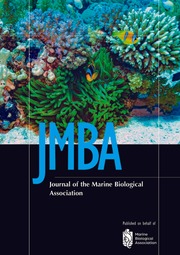No CrossRef data available.
Article contents
Growth of the bobtail squid Euprymna hyllebergi (Cephalopod: Sepiolidae) from the southeastern Arabian Sea using statolith microstructure
Published online by Cambridge University Press: 04 April 2025
Abstract
Bobtail squids of the family Sepiolidae, which includes the genus Euprymna, are closely related to, but distinct from the true squids (Teuthoidea). Despite their ecological importance, there have been few studies on the age and growth of bobtail squids using hard parts. This study is the first to use statolith increments to estimate the age of Euprymna hyllebergi collected from the southeastern Arabian Sea. Statoliths were extracted from 80 individuals (24 males, 56 females) of dorsal mantle length (DML) 8–50 mm and total weight 0.45–37 g and assessed for their age. Statolith size ranged from 328 to 836 μm. Assuming a daily deposition of increments, growth was rapid and adult sizes were attained in around 2 months. The age of the individuals varied between 25 days (DML = 8 mm) and 91 days (DML = 37 mm) for males; 33 days (DML = 10 mm) and 92 days (DML = 44 mm) for females. The daily growth rate ranged from 0.20 to 0.49 mm DML day−1 for males and 0.23–0.59 mm DML day−1 for females. The lifespan of E. hyllebergi is short, based on the statolith increment analysis.
- Type
- Research Article
- Information
- Copyright
- Copyright © The Author(s), 2025. Published by Cambridge University Press on behalf of Marine Biological Association of the United Kingdom


